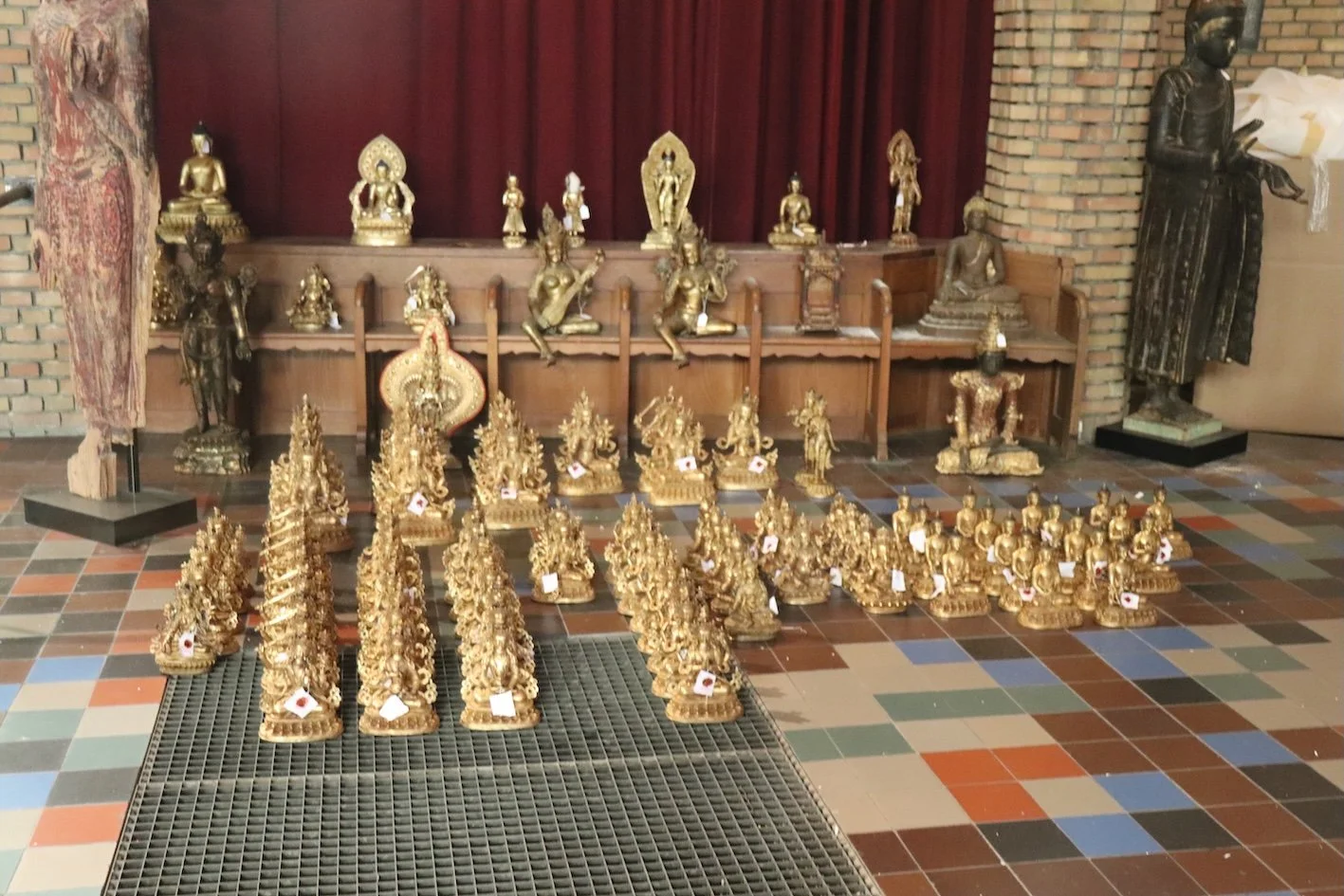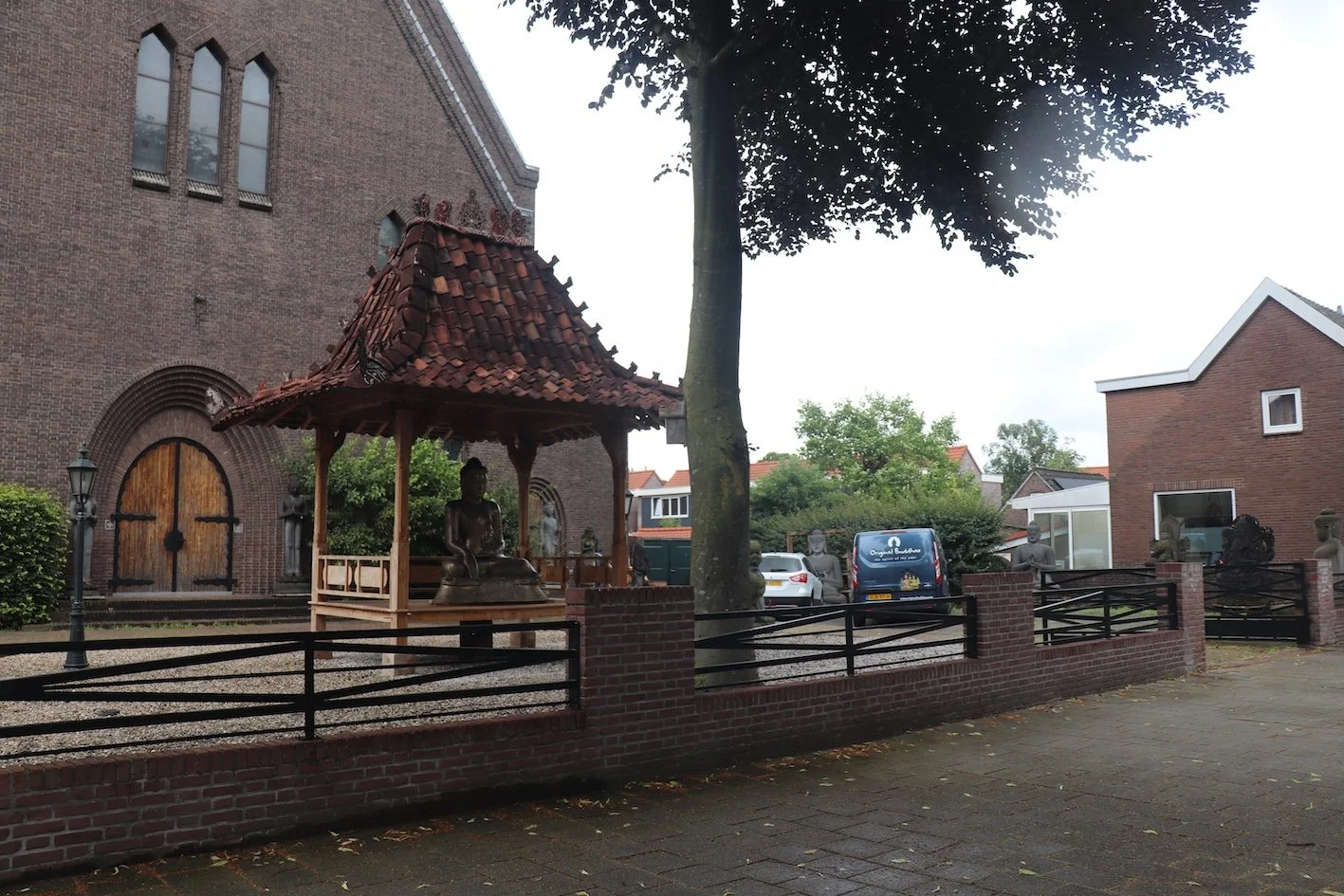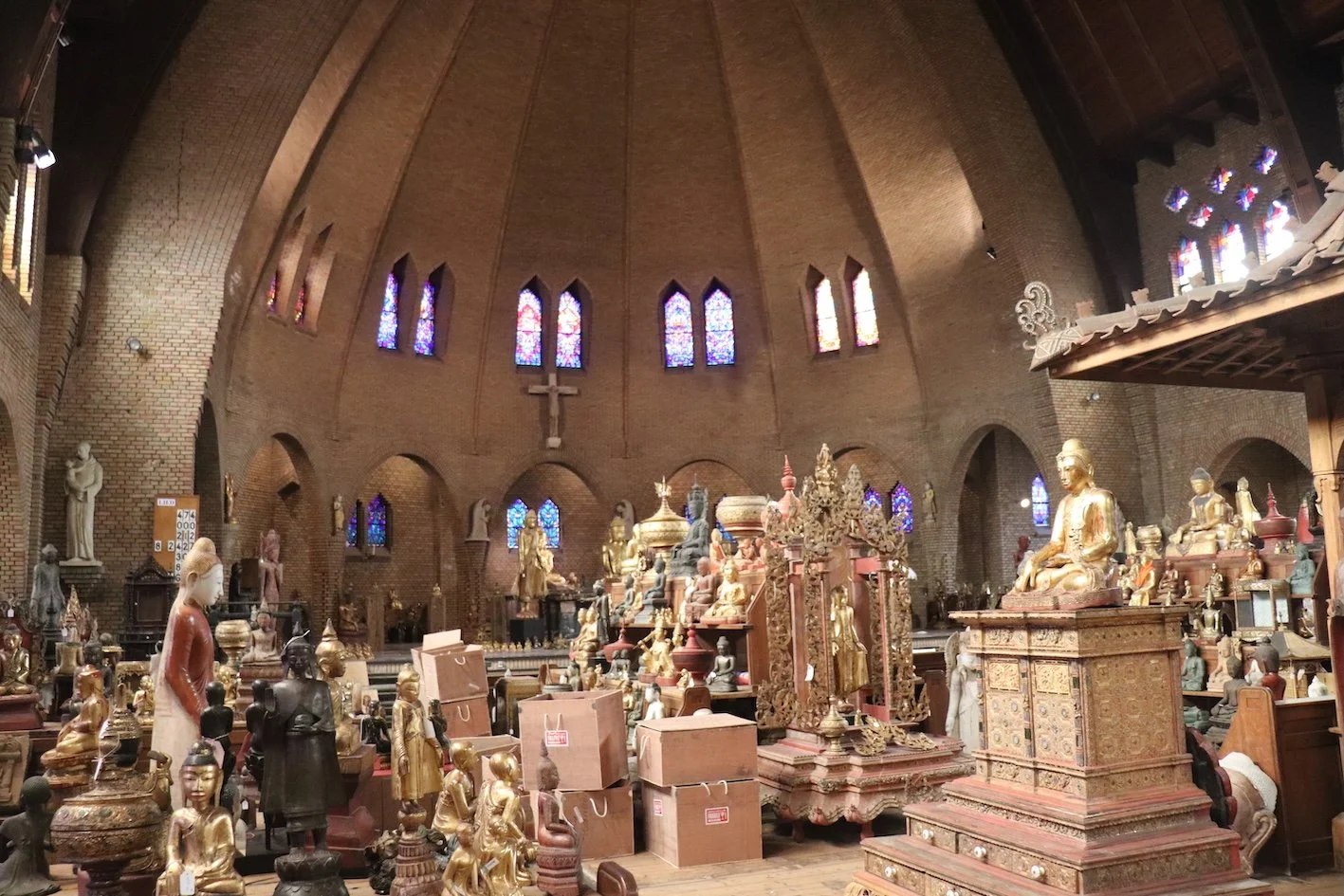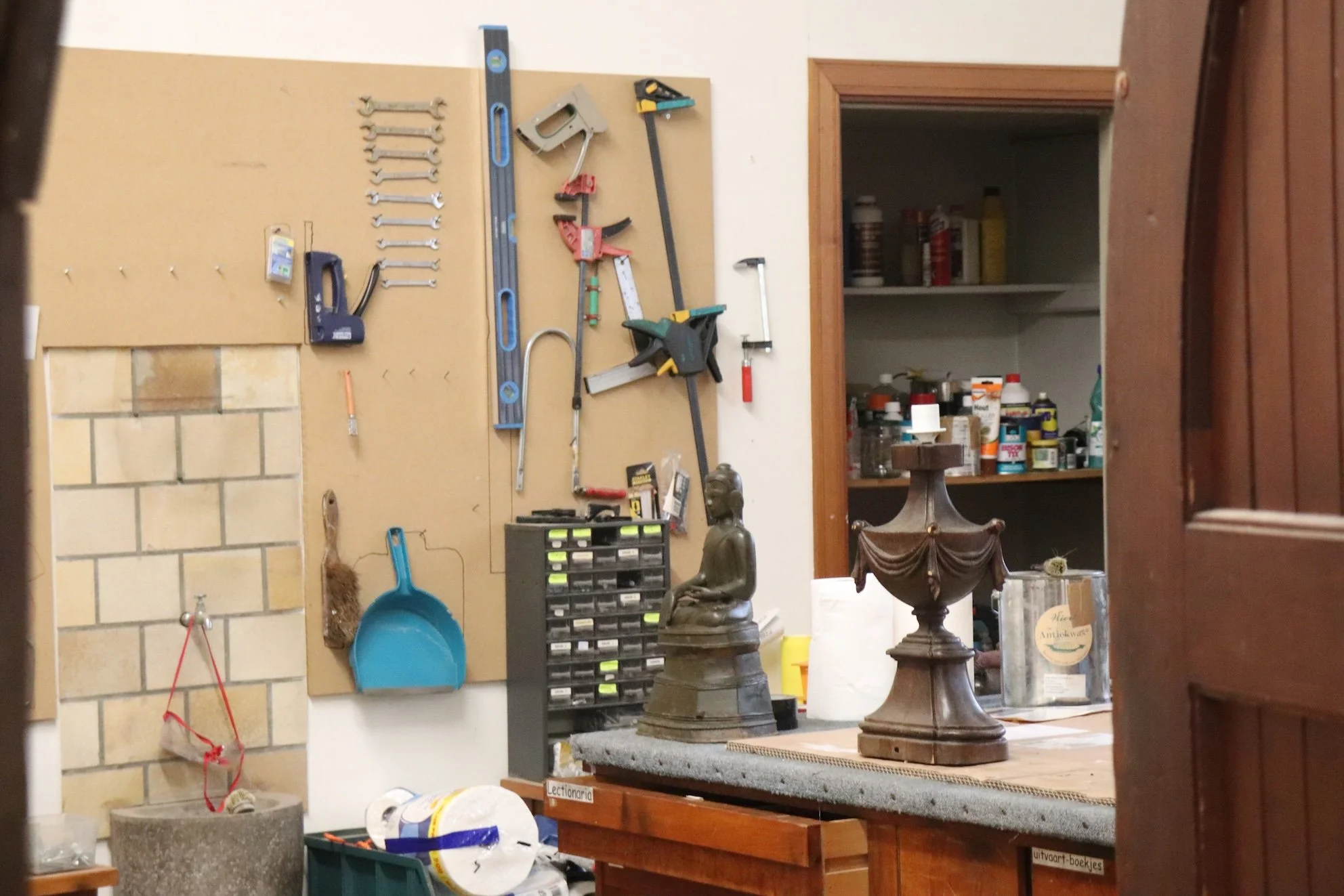Original Buddhas/ Johannes Vianneykerk, Deventer
By Archishman Sarker
Introduction
My encounter with the Original Buddhas collection is largely coincidental. In the summer of 2024, while in Amsterdam for a pre-conference workshop at the University of Amsterdam, I was exploring important private collections of Asian Buddhist art in the Netherlands. I had already visited some prominent private galleries of Buddhist art in the heart of Amsterdam like the Astamangala Gallerie in Keizersgracht, when I came across Original Buddhas as a very eccentric and exceptional collection, and also very symbolically housed in a now-defunct and repurposed Christian church in the Dutch town of Deventer, a few kilometres east of Amsterdam. The building in which the collection is housed bears a striking semblance to The Tibet Museum of the Fondation Alain Bordier in Gruyères, Switzerland, established in 2009. Both institutions – one a commercial dealership, the other a museum – are housed in repurposed Christian spaces, highlighting a broader trend in Western Europe where deconsecrated churches are repurposed or adapted for new purposes. While many such structures are converted into boutique hotels or non-religious venues, some exceptions like Original Buddhas uniquely preserve their spiritual undertones by hosting objects of religious reverence from non-Western traditions. The Johannes Vianneykerk in Rielerweg, Deventer, housing Original Buddhas, was acquired and repurposed by its founder Peter in 2016, and offers a striking juxtaposition of Christian and Buddhist aesthetics. It is located on the Rielerweg and named after Johannes Maria Vianney (1786-1859), the Catholic patron saint of parish priests, who was canonised in 1925. Until 2014 it was used by the Roman Catholic parish of the same name. The building of the church dates from 1929 and was included in the register of national monuments of the Netherlands in 1999. It was designed by a local architect Martin A. Roebbers, who designed it in the form of a basilica. The church has three naves under a saddle roof with a roof turret. The altar is relatively shallow compared to other early twentieth century Dutch churches. The geometric figure of the parabola was used extensively for the sober expressionist design in clean brickwork. The church was built on the site of the Kolk van Zandvoort, which was once created by a dyke breach in the IJssel. After the Kolk was filled in, concrete piles were driven to form the foundations of the building because of the peaty subsoil. Originally, a tower was planned to be built next to the church; this did not happen due to the Dutch economic crisis of the ‘thirties. At the end of 2013, the newly formed merged parish for Deventer and the surrounding area was ordered by the diocese to close the church, together with four others, necessitated by the decline in the number of church members and the reduced participation of parishioners in church life. On 2 February 2014, the last regular celebration was held in the church, and on 29 June 2014, the last Holy Mass was celebrated to mark the closure, following which the church building was officially withdrawn from worship by the bishop. In the search for possibilities for repurposing, the parish board called in experts as well as students from Saxion University, Enschnede. In 2016, the Vianney Church became the property of Peter Vredeveld, a dealer in Buddha statues and Asian art. The zoning plan of the town of Deventer had to be adjusted to allow for an art gallery in the church. With respect for the monumental value of the building, a gallery for Asian art was also planned to be established there. However as of March 2025, this is yet to be fulfilled.
Fig. 1.
Fig. 2.
From the outside (Fig. 1), the outdoor courtyard, adorned with large Buddha sculptures and a central pagoda, contrasts sharply with the church’s Christian architecture. Inside (Fig. 2), the transformation is even more dramatic: thousands of artefacts, meticulously arranged, span a variety of media, sizes, and religious traditions, including Buddhist, Brahmanical, and Jain objects. Vredeveld’s decades-long career in art dealing, bolstered by extensive travel in India, Nepal, and Myanmar, has enabled him to establish a global network of craftsmen, dealers, and collectors. However, as he noted during my visit, sourcing artefacts has become increasingly challenging, particularly from Myanmar, due to escalating political turmoil. This underscores the geopolitical complexities shaping the trade in cultural objects. The collection’s global reach is evident in its operations, with artefacts continuously arriving from South and Southeast Asia and being prepared for shipment to clients worldwide. The sight of unpacked crates and newly packed shipments within the church aptly reflects the nature of this enterprise, blurring the boundaries between sacred art, commerce, and mediated cultural exchange. This convergence of religious heritage and market forces simultaneously raises questions about the ethics of cultural preservation and the commodification of Asian sacred objects in contemporary Europe.
Background and history
The provenance of Asian collections in the Netherlands frequently traces back to significant private collections within Europe, a pattern consistent with institutional collections across the continent. For instance, much of the Asian art housed in institutions like the Rijksmuseum originated from societies such as the Society of Friends of Asian Art or the Royal Asian Art Society. These societies, in turn, relied on the acquisitions of private collectors, traders, and antiquarians active across Europe. This layered provenance underscores the pivotal role private collections played in the establishment and expansion of institutional collections during the early to mid-twentieth century. The art market for Asian antiquities, particularly Buddhist religious artefacts, was well-established long before the 1960s and ‘70s, facilitated by a robust network of dealers and collectors. However, a discernible shift occurred in the relationship between private and institutional collections during the latter half of the twentieth century. Prior to this period, private collections were instrumental in shaping the identity and scope of institutional holdings, often serving as their foundational sources. This well-oiled set-up was most prolific until the mid-twentieth century when private collectors actively supplied institutions with culturally significant objects. From the 1960s and ‘70s onward, however, the role of private collections became increasingly peripheral to institutional acquisitions. This shift can be attributed to two interrelated factors. First, a decline in institutional funding and enthusiasm for acquiring new material significantly curtailed the scale of acquisitions. The post-war period also saw a reorientation of priorities within museums and cultural institutions, reflecting broader socio-economic and political changes. Second, the emerging imperative to ‘decolonise’ museum collections introduced a new layer of scrutiny to acquisition practices. Institutions became increasingly cognisant of the ethical and political ramifications of acquiring objects with ambiguous or problematic provenance. This awareness has been amplified by the growing demand for transparency and accountability in the art world, as well as the broader cultural reckoning with colonial histories. Thus, the relationship between private and institutional collections has undergone a fundamental transformation. While private collections once actively shaped institutional holdings, they now exist largely as complementary entities. The reception of Buddhist art in the Netherlands, particularly during the mid-twentieth century, was profoundly shaped by the countercultural movements that emerged in the post-war period. These movements, which sought to challenge established norms and hierarchies, often turned to non-Western philosophies and aesthetics as alternative frameworks for understanding spirituality, existence, and artistic expression. In this context, Buddhist art came to be viewed not merely as cultural artefacts but as conduits to a deeper, universal wisdom that resonated with the counterculture’s rejection of materialism and institutionalised religion. This reimagining of Buddhist art as a spiritual and philosophical resource contributed to its aesthetic and intellectual valorisation within European cultural spaces, particularly in countries like the Netherlands, where a growing interest in Asian philosophies coincided with the rise of progressive and experimental cultural practices. Buddhist art began to circulate widely, not only within museums and cultural institutions but also in private spaces, galleries, and commercial establishments. The concurrent rise of the New Age movement amplified demand for Buddhist artefacts, blending spiritual experience with consumer culture. This period also marked a turning point for amateur Dutch collectors, often middle-class individuals without formal training, who ventured into Asia to pursue careers in art dealing, and other consumerist-oriented professions that allow them to bank on the experience of their travels.
However, this countercultural reception often resulted in the decontextualisation of Buddhist art, as its religious and historical significances were subsumed under broader narratives of personal enlightenment and aesthetic transcendence. By focusing on the perceived universality of Buddhist themes, such as impermanence and meditation, the counterculture often overlooked the specific cultural, political, and historical contexts in which these artworks were created and functioned. In the Dutch context, this tendency was further complicated by the colonial legacy, particularly in relation to Indonesia, which had long been a source of Buddhist and other Asian art for European collections. The countercultural fascination with Buddhism thus intersected with ongoing colonial narratives, creating a complex relationship in which Buddhist art was both celebrated and estranged from its original contexts. This dual process of valorisation and decontextualisation has had lasting implications for the reception of Buddhist and Asian art in the Netherlands. While countercultural movements expanded the audience for these works and introduced new modes of engagement, they also simultaneously contributed to a flattening of their cultural and historical depth. The emphasis on aesthetic and spiritual qualities, often detached from provenance and cultural specificity, has thus perpetuated a fragmented understanding of Buddhist art.
The Collection
Original Buddhas in Deventer stands as one of the most prominent art dealerships specialising in Buddhist art from South and Southeast Asia in the Netherlands, with extensive supply chains across Europe and beyond. Its founder Peter Vredeveld, a young Dutch gentleman in his ‘40s, has an extensive record of travelling as a backpacker in South and Southeast Asia in the ‘80s, ‘90s and early 2000s, which led to a deep interest in the arts, antiquities, religions and cultures of these regions; these formative experiences inspired his transition into art collecting and trading. He has been active as a trader and collector of Asian religious art for the last three decades, and has over the years built an impressive collection of arts and antiquities from South and South East Asia, with Buddhist objects predominant, which led to the branding of his company: “Original Buddhas.” Peter is still an active traveller, art collector and trader. He lives with his wife from Nepal, in a house next to the church, and still often visits countries in South and Southeast Asia like India, Nepal, Thailand, Indonesia, from where he sources most of his objects, and he regularly attends important Buddhist and Asian art sales events across Europe. Peter’s collection is an exemplary repository of Asian art and antiquities, meticulously categorised and curated to reflect a sophisticated interplay between antiquity and contemporary craftsmanship. The collection is strategically divided into two primary wings, each serving distinct purposes and audiences. The first, designed for regular sales, features objects generally priced between €300 and €500, with certain exceptional items reaching up to €10,000. This wing caters to a broader clientele, providing access to artefacts that balance aesthetic appeal with affordability. In contrast, the second wing, referred to on the Original Buddhas website as the "Private Collection," is a repository of high-value objects priced between €10,000 and €100,000. This categorisation not only delineates the economic value of the objects but reinforces the exclusivity of the collection’s most significant possessions. The breadth of the collection is reflected in its extensive categorisation, which includes Buddha statues, Buddha heads, Hindu deity statues, Guan Yin figures, temples or shrines, Burmese nat sculptures, opium weights, singing bowls, furniture, and garden statues. The collection’s physical arrangement within a repurposed church definitely accentuates its grandeur and thematic coherence. The nave of the church is dominated by a monumental Burmese pagoda temple (Fig. 3), which serves as the focal point of the collection. Surrounding this centrepiece are sculptures, architectural fragments, and miscellaneous artefacts sourced predominantly from Myanmar, Nepal, India, and Thailand, creating a spatial narrative that emphasises the interconnectedness of these regions’ artistic traditions. The north and south transepts (Figs. 4 & 5) are reserved for antique sculptures, including Buddhist, Brahmanical, and Jain works, as well as architectural fragments, underscoring the thematic and historical diversity of the collection. The elevated platform (Fig. 6) of the main altar prominently displays one huge bronze seated Buddha, flanked by two very large standing bronze Buddhas— all three from Myanmar, probably made during the eighteen-nineteenth century. It also is adorned with an array of bronzes (Fig. 7), primarily depicting Buddhist deities and other miscellaneous ritual objects (Figs. 8a & 8b). In contrast, the sanctuary floor features contemporary and less costly bronze representations of Buddhist deities (Fig. 9), which are recent acquisitions, situating the collection within an ongoing continuum of artistic production. Also noticeable is a huge nineteenth-century temple bell from Maynamar (Fig. 10). Some other major pieces in this collection are: a wooden Buddha in the bhūmisparśamudrā, attributed to the Pāla style, but produced much later in the seventeenth-eighteenth centuries in the Bihar region of northeastern India, a tenth-twelfth century sandstone head of a Jain tīrthaṅkara from northern/ western India, a seventeenth century Burmese bronze Buddha in the bhūmisparśamudrā, another sixteenth-seventeenth century large Buddha sculpture in the bhūmisparśamudrā with a venerating monk on each side facing him (Fig. 11), a seventeenth-century Nepalese stone Viṣṇu (Fig. 12), a sixth-ninth-century bronze Buddha (Fig. 13) in the bhūmisparśamudrā from upper Myanmar, a bronze Buddha (Fig. 14) from the early Pagan period (eleventh to thirteenth centuries C.E.) with traces of lacquer and gold gilding, etc, a number of Jain altarpieces in wood and bronze, sourced mainly from northern and western India. These objects are just a minuscule representation of his entire collection of antique bronzes, a large number of which are yet to be archived for the website. Architectural fragments like a large nineteenth-century Burmese wooden temple panel, gilded with gold, stand out as some of the most aesthetically valued architectural fragments in his collection; other objects include sandstone and wooden architectural fragments from seventeenth-nineteenth century northern and western India. These fragments, often with intricate carvings and gilding, are valued for their aesthetic appeal and their ability to evoke the architectural grandeur of their original contexts. Opium weights in the collection are mostly made of brass and from Myanmar, mainly produced during the eighteenth-nineteenth centuries (when opium, introduced by the British, was popular in the region), in a variety of designs. A particularly under-explored yet intellectually rich segment of the collection is its assemblage of ephemera and ritual objects. These include Nepalese and Tibetan protective spells (Fig. 15), sacred cloths inscribed with Buddhist texts, ritual containers, etc. Peter also has some finely-preserved seventeenth-century manuscripts (Fig. 16) with wooden covers (Fig. 17) from Myanmar. While these objects are not prominently featured in the collection’s sales or online archives, they provide insights into the ritual practices and everyday religiosity of their respective cultures. Their inclusion in the collection attests to a curatorial vision that seeks to preserve not only the monumental and the grandiose but also the ephemeral and the quotidian. The sculptures which are located outside in the courtyard of the Original Buddhas compound are mainly contemporary pieces from India, Nepal, Indonesia and Thailand.
















In discussions with Peter, I discerned that while his clientele is primarily in continental Europe, his market extends to the United States, the United Kingdom, and at times, private collectors in Asia, including Singapore, China, Japan, Korea, and India. Peter’s operations reflect two distinct facets of the art and antiquities trade: catering to connoisseurs and specialists seeking high-value objects, and addressing the burgeoning popular demand for contemporary religious artefacts, often as souvenirs or decorative items. Recognising the equal significance of these markets, Peter sources high-value pieces through rigorous provenance inquiries, particularly for items originating in South and Southeast Asia, and acquires rare objects at European auctions. However, his focus has shifted toward supplying popular demand, especially for Buddhist religious images from Nepal, as evidenced by the composition of his collection, which is predominantly of objects acquired during his past travels and purchases. Recent geopolitical instability in Myanmar has disrupted his ability to procure antiquities from a region where he had long-standing connections. His operation remains largely self-managed, with limited staff dedicated to tasks such as photography, website maintenance, packaging, and transportation. Peter personally oversees object care and manages a small workshop (Fig. 18) for repairs and conservation. The accessibility of private collections to scholars is often restricted, exacerbated by the lack of uniform regulations governing their use for research purposes. However, my experience with Peter’s collection, particularly as a South Asian researcher specialising in Buddhist art, contradicts this general trend. The openness and accessibility I encountered at Original Buddhas exemplify a model of private collection management that facilitates scholarly engagement, offering a commendable level of access for academic inquiry.
Fig. 18
Conclusion
The collection transcends the conventional boundaries of artefact aggregation, emerging instead as a meticulously curated cultural archive that embodies different narratives of artistic production, historical exchange, and religious practice across Asia. Its thematic breadth and spatial organisation underscore a deliberate engagement with the material and symbolic dimensions of its objects. The collection challenges the dominant historiographical frameworks of institutional collecting by privileging a personalised, eclectic approach that foregrounds aesthetic and cultural pluralism. As a private collection, it operates as a form of counter-history, resisting the homogenising tendencies of national and museum narratives while offering an alternative lens through which to study and appreciate the complexities of Asian Buddhist art. This mode of private collecting reconfigures the epistemological terrain, suggesting that such collections, while often dismissed as idiosyncratic or market-driven, possess the capacity to disrupt and reimagine the historical narratives they ostensibly reflect.
Further Reading
Groys, Boris. 2022. ‘Collector as Curator: Collecting in the Post-Internet Age.’ In Johannes Endres and Christoph Zeller (eds), Collecting in the Twenty-First Century: From Museums to the Web: 57–66. Boydell & Brewer.
Hanegraaff, Wouter J. 1997. New Age Religion and Western Culture: Esotericism in the Mirror of Secular Thought. New York: State University of New York Press.
De Lang, Laura, . 2018. The Asian Pavilion at the new Rijksmuseum: a misrepresentation of the Dutch East Indies [Unpublished Master’s Thesis]. Freie Universität Berlin. doi:10.13140/RG.2.2.27977.60008.
Khan, Shireen Ikramullah. 2022. "The ‘Other’ Culture: The Asian Pavilion at The Rijksmuseum in Amsterdam.” The Karachi Collective: Critical Dialogue on Art, Design, and Culture. 7 April, 2022. https://thekarachicollective.com/the-other-culture-the-asian-pavilion-at-the-rijksmuseum-in-amsterdam/ (accessed 20 December 2024).
Lindner, Christoph, and Andrew Hussey, (eds.). 2013. Paris-Amsterdam Underground: Essays on Cultural Resistance, Subversion, and Diversion. Amsterdam: Amsterdam University Press.
Löseke, Annette and Anna Grasskamp. 2014. “Framing ‘Asia’: Results from a visitor study at the Rijksmuseum’s Asian Pavilion.”Aziatische Kunst, 44(2), 49-55. https://doi.org/10.1163/2543-1749-90000380
Oostindie, Gert. 2011. ‘Postcolonial’ (in the) Netherlands. In Postcolonial Netherlands: Sixty-Five Years of Forgetting, Commemorating, Silencing: 215–242. Amsterdam: Amsterdam University Press.
Original Buddhas. 2024. ‘Catalog’. https://www.originalbuddhas.com/catalog (accessed 20 December 2024).
Royal Asian Art Society in The Netherlands. https://www.kvvak.nl/en/asian-art-society/ (accessed 20 December 2024).
Stremmelaar, Josine and Paul van der Velde. 2006. ‘What about Asia?: Revisiting Asian Studies.' In J. Stremmelaar and P. van der Velde (eds.), What about Asia?: Revisiting Asian Studies: 7–14. Amsterdam: Amsterdam University Press.
Tibet Museum/ Alain Bordier Foundation. 2024. https://en.tibetmuseum.ch/le-musee (accessed 20 December 2024).
Archishman Sarker is an art historian, and he teaches at Ashoka University.


